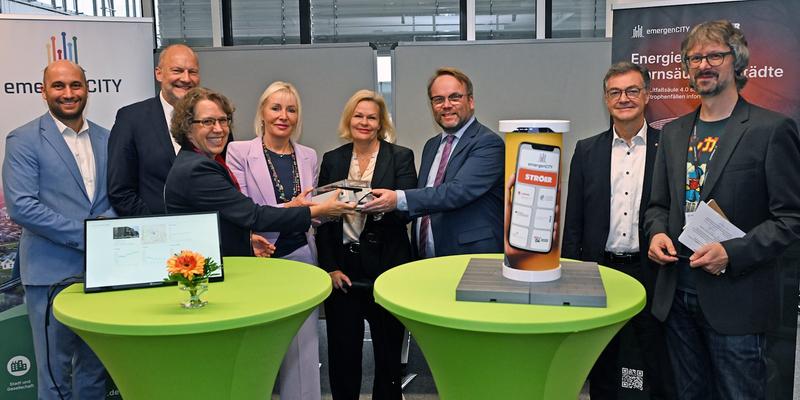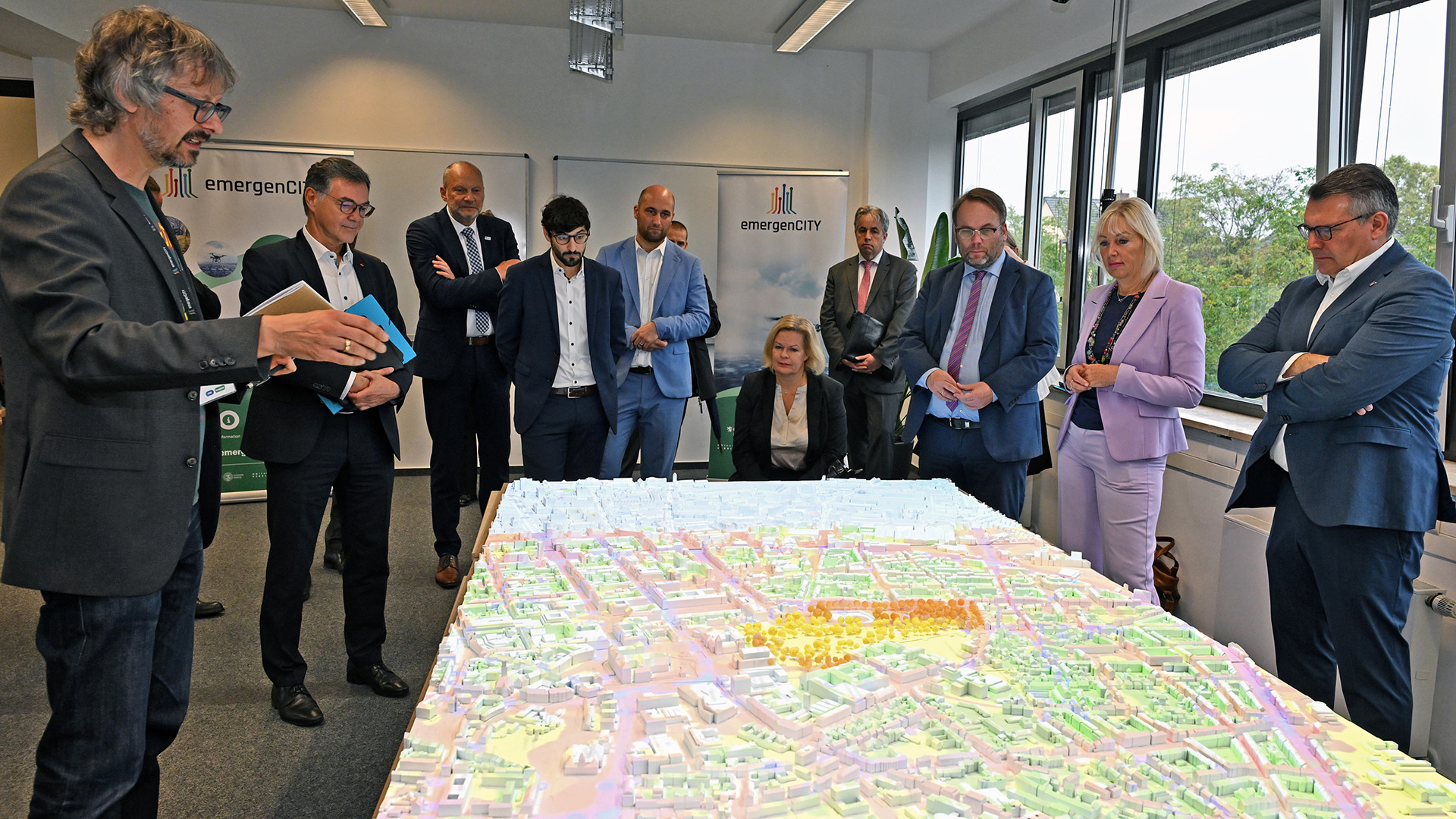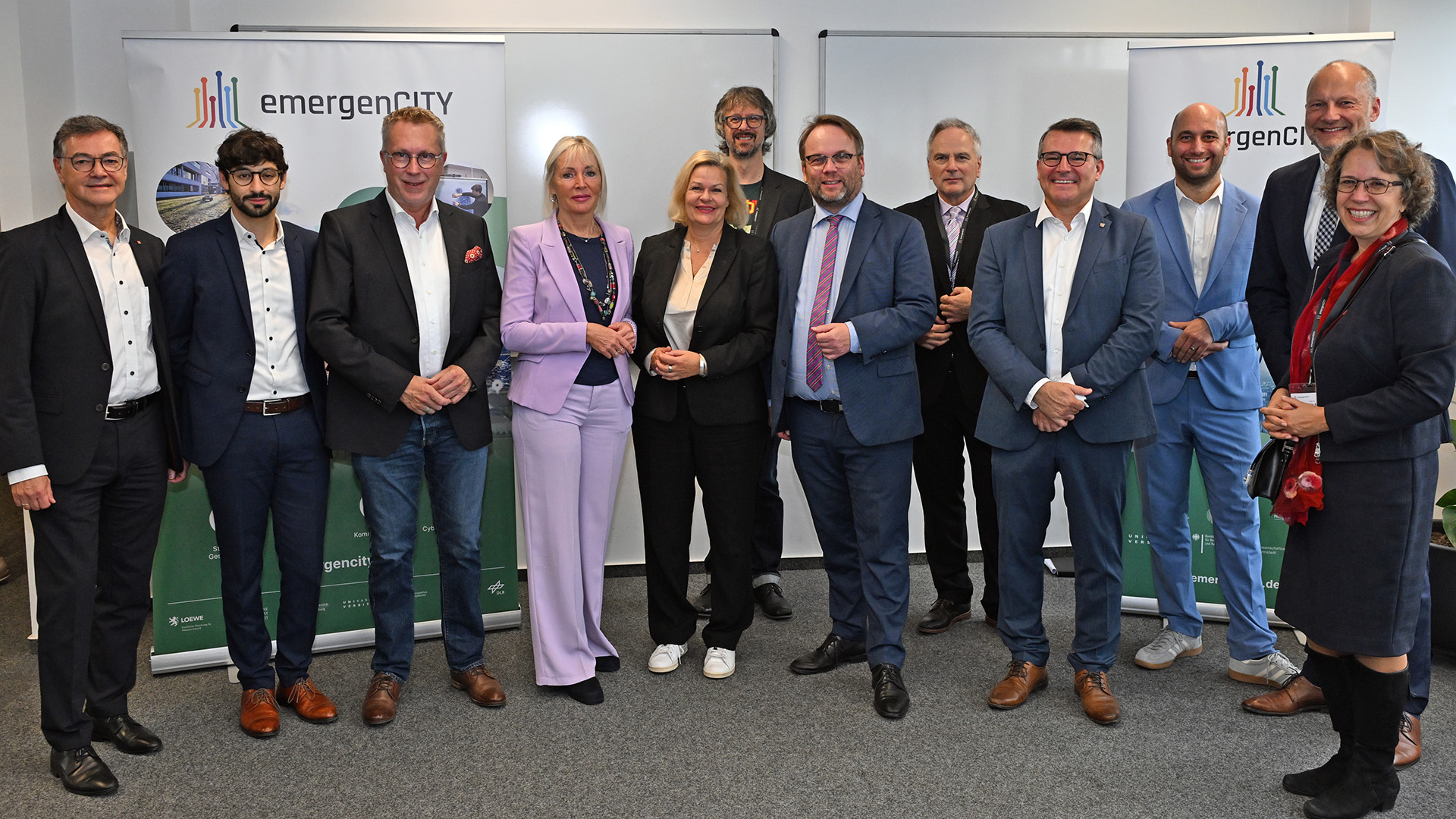Strengthening Digital Resilience
Faeser, Sinemus and Gremmels visit LOEWE center emergenCITY at TU Darmstadt
Faeser, Sinemus and Gremmels visit LOEWE center emergenCITY at TU Darmstadt

Better preparing society for disasters: It is a goal that unites the Federal Minister of the Interior and Community, Hesse’s Digital Minister and Hesse’s Science Minister, the Federal Office of Civil Protection and Disaster Assistance (BBK) and emergenCITY researchers. On Monday, October 7, scientists from the LOEWE center emergenCITY presented innovations in research on digital emergency communication to Federal Minister of the Interior Nancy Faeser, Hesse’s Digital Minister Kristina Sinemus, Hesse’s Science Minister Timon Gremmels and BBK President Ralph Tiesler in Darmstadt.
Floods, power outages or cyber attacks can quickly paralyze communication channels via smartphone, radio or television. But especially in a disaster, people want to be informed and know where they can get support or how they can help themselves. Digital information and communication technologies are crucial here, said Federal Minister of the Interior Nancy Faeser.
“Good warning systems save lives in an emergency. This applies regardless of whether we are talking about fires, severe storms, forest fires or other dangers. We have invested heavily in a good and reliable mix of warning systems in recent years and are constantly improving them. Digital resilience is an important component in strengthening the resilience of the state and society as a whole against disasters,” emphasized the Federal Minister of the Interior.

The guests were shown how resilient, digital solutions can improve emergency communication in an urban district in the laboratory of the LOEWE center emergenCITY at TU Darmstadt.
Timon Gremmels, Hesse’s Minister of Science, said: “In emergenCITY, researchers are working on solutions that will ensure emergency operations in the event of a crisis and enable rapid assistance and a return to normality. emergenCITY thus vividly demonstrates the important role our universities and non-university research institutions play in overcoming the challenges of our time.” Since 2020, the Hessian Ministry of Science and Research has supported the researchers with around 22 million euros.
“With emergenCITY’s research, we are a pioneer in Germany,” said Hesse’s Digital Minister Prof. Dr. Kristina Sinemus. “In order to further strengthen the resilience of digital infrastructures and protect the Hessian economy from future crises and disasters, we will establish an application-oriented “Crisis Resilience Center”.”
Matthias Oechsner, Vice President of TU Darmstadt, explained that the comprehensive treatment of the socially highly relevant topic of digital resilience, which ranges from basic research to transfer in emergenCITY, makes emergenCITY a lighthouse project of TU Darmstadt. Matthias Hollick, scientific coordinator of emergenCITY, referred to the necessary interdisciplinarity of the center, in which scientists from different departments work together on resilient information and communication technologies.
The computer science professor presented application-oriented research projects on emergency communication in urban districts to the ministers and the BBK President. For example, emergenCITY is supporting the city of Darmstadt in the “Digitaler Heinerblock” project to transform a traffic-calmed neighborhood. The scientists are developing sensor boxes for street lamps that send messages from the authorities to smartphones in the event of a disaster.
“Communication in the event of a disaster is essential, sometimes even vital,” explained Matthias Hollick. “Our goal is to develop resilient information and communication systems that enable people in cities to remain capable of acting during and after a disaster in order to quickly return to normality.” For the BBK, resilience also comes from redundancy, i.e. the simultaneous availability of systems that are independent of one another.
BBK President Ralph Tiesler emphasized the important role of resilient information systems: “On the nationwide warning day, for example, we reached 95 percent of people through the interaction of various warning tools. We need to implement further digital innovations in civil protection practice in the future in order to position ourselves for resilience.”

One of these innovations is the “advertising pillar 4.0”, a digital, energy-autonomous warning component for advertising pillars that displays information and instructions to residents during a prolonged power outage. “In emergenCITY, computer scientists, social scientists and humanities scholars work hand in hand to ensure that information technology solutions can also be taken into account in urban policy decisions,” explained Michèle Knodt, deputy coordinator at emergenCITY and Professor of Political Science at TU Darmstadt.
Matthias Hollick concluded by emphasizing: “Here at emergenCITY, we go beyond optimally warning the population in the event of disasters. We are also researching how digital systems can increase the resilience of society in general instead of endangering it.”
The ministers’ visit was accompanied by SPD member of parliament Andreas Larem and Hessian state parliament members Bijan Kaffenberger (SPD) and Peter Franz (CDU).